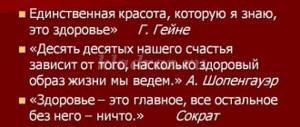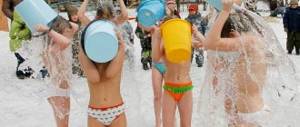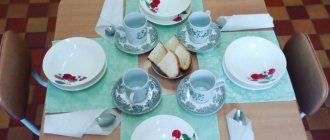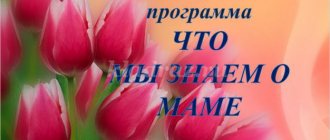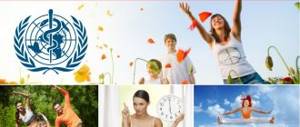For health, go to kindergarten. Project with children of the 2nd junior group - presentation
The project with children of the 2nd junior group “For health in kindergarten” (Project of effective interaction between teachers and parents when carrying out physical education and health work with children.) was prepared by: teacher of MBDOU d/s 11 Podgornaya N.S.
The greatest value for a person is health. The preamble to the Constitution of the World Health Organization describes health as “a state of the greatest physical, psychological and social well-being and not merely the absence of disease or infirmity.”
Relevance of the project The main goal is currently a constant search for methods of improving the health of children in a kindergarten. The main goal is to reduce the incidence of children; First of all, the ability of children to master all the skills and abilities that are instilled in them in kindergarten and that they need for effective learning in the future depends on the state of health. To do this, it is necessary to develop diverse knowledge and positive character traits in children, and improve physical development; Teachers need to properly organize educational work with preschool children. It is necessary to take into account the age and psychological characteristics of children, create favorable hygienic conditions, and an optimal combination of various types of activities. The foundation of human health is laid in early childhood; It is also necessary to constantly search for new forms of interaction with the family of pupils.
Problematic question: How and with what help to preserve and strengthen the health of preschool children?
Description of the project Project type: information-practice-oriented. Project participants: group teachers, students and parents of the 2nd junior group, additional education teachers. Duration of the project: Start: October 2012 End: May 2013 Duration: long-term, one academic year. Object of study: the process of healing of children of the 2nd junior group of MBDOU d/s 11 in Belgorod. Subject of research: traditional and non-traditional types of health work as the most effective means of improving the health of children of primary preschool age.
PROJECT GOAL: Reducing morbidity, maintaining and strengthening the health of children of primary preschool age.
PROJECT OBJECTIVES: to develop an understanding of the need to take care of your health, protect it, learn to be healthy and lead a healthy lifestyle; instill a love of physical exercise and hardening; increase parents' literacy in matters of education and health promotion of preschool children.
Stages of project implementation: 1. Organizational and preparatory (September - October) 2. Implementation (October - May) 3. Final (April - May)
Organizational and preparatory stage Accumulation of information. Observations of children. Problem analysis. Studying methodological literature on the topic “Health”, “Traditional and non-traditional means of improving the health of preschool children”. Work with periodicals “Preschool Education”, “Hoop”, “Preschool Education”, “Preschool Pedagogy”. Questioning parents on the topic of the project, processing personal data. Development of a project on the topic “For health in kindergarten.” Excursions and targeted walks. Manufacturing of non-traditional equipment in accordance with the theme of the project. Conversations. Examination of illustrations, reproductions, paintings, etc.
Implementation stage 1. “If you want to be healthy...” (psycho-emotional games; games-exercises for developing correct posture; exercises for correcting flat feet; recreational games, play therapy; KGN, hardening). 2. “This is who I am” (GCD for developing ideas about the world and oneself). 3. “Creative workshop” (joint productive activity of children and parents). 4. “On the bookshelf” (reading children's literature, memorizing poems, nursery rhymes). 5. “Have fun, kids!” (health-improving leisure activities, holidays, entertainment, health days, themed walks, play activities). 6. “For moms and dads” (information, photo exhibitions, surveys, questionnaires, parent meetings, consultations.)
1. “If you want to be healthy...” TASK: Using various methods of improving the health of children in accordance with the age, individual characteristics of the children and the wishes of the parents.
“If you want to be healthy...” 1. Consultation for parents “Hardening children in preschool age” 2. Traditional methods of hardening 3. Survey of parents “Methods of hardening” 4. Non-traditional means of improving children’s health (health games, games that heal, play therapy, exercises – games for diseases of the nose and throat, exercises for the prevention and correction of flat feet, “weather massage”, gymnastics for the toes, foot massage)
Traditional methods of hardening in the second junior group: 1. Morning exercises. 2. Clothes in the group and outside according to the weather. 3. Walks every day with outdoor games. 4. Sleep without T-shirts (taking into account the air temperature in the group and the wishes of the parents). 5. Walking barefoot before and after sleep. 6. Gymnastics and walking on ribbed paths. 7. Phytoncides – onions, garlic. 8. Washing with cold water.
Traditional methods of hardening in the second junior group:
Non-traditional means of improving children's health Health games “Heron”, “Horses”
Health games “Ears” “Cat”
Games that heal “The shepherd blows the horn” “Control the winds”
Play therapy Exercises on the surface of water and sand related to tactile and kinesthetic sensitivity, relieving emotional stress
Exercises for the prevention, correction of posture and flat feet Complex “A grasshopper was sitting in the grass...”
“I am like this” Planning of educational activities for the development of ideas about the world and about oneself. 1.Where does vitamin live? 2. It's me! 3. Sense organs (eyes, ears, nose). 4.What are eyes for? 5. The organ of hearing is the ears. 6. Organs of hearing, taste, smell (ears, mouth - tongue, nose). 7.What are teeth needed for? 8.My clothes (winter, spring, summer, autumn). 9. Excursion to the medical office of the kindergarten. 10.How to be healthy?
“Creative Workshop” OBJECTIVE: Carrying out health-improving work with children and enriching the developmental environment in the group with the interaction of teachers, children and their parents.
“Creative workshop” 1. Replenishment of the Health Center in the group. 2. Collective and individual work of children on the topic: “Health and ill health” 3. Creation of an educational environment for the development of fine motor skills. 4. Production of a health information center for parents. 5.Planning classes on productive activities (drawing, modeling, appliqué).
“On the Bookshelf” OBJECTIVES: to cultivate a caring attitude towards one’s health through reading children’s literature; use Russian folk nursery rhymes, sayings, pestushki when washing, combing and braiding girls’ hair; memorize poems about health.
“Have fun, kids” OBJECTIVES: to cultivate a caring attitude towards your own and others’ health; develop motor activity of children; create psychological and emotional comfort in the group.
“Children have fun” 1. Health days 2. Thematic walks 3. Game activities: Didactic games Role-playing games Active 4. Wellness minutes Finger games Physical exercises
“For Moms and Dads” OBJECTIVES: to introduce parents to methods of improving the health of children in kindergarten and at home; involve parents in the work to improve the health of children in kindergarten.
“For moms and dads” 1. Consultation for parents “Educating the basics of a healthy lifestyle in preschool children.” 2. Information “Morning exercises for children”, “Tips for promoting children’s health”, “How to teach a child to brush their teeth”, “Useful nutrition tips”, “Health and nutrition of preschool children”. 3. Parent meetings. 4. Creative activity of parents.
The final stage is monitoring the incidence level; demonstration of educational activities directly at the parent meeting (May); photo collage “For health in kindergarten” (May); exhibition of children's drawings; a book of joint creativity between group teachers, children and their parents, “Health is Simple.”
Information base of the project: Health-saving space and preschool educational institution, N.I. Krylova, publishing house "Teacher", 2009. Develop agility, strength, and endurance in preschoolers. E.N. Krylova, M, “Enlightenment”, 1981. We play with the kids. Grigorieva G.G., M., 2003. Learning to be healthy, L.A. Teplyakova, S.Z. Shishova, M. 2001, Entertaining physical education in kindergarten K.K. Utrobina.- M.: GNOM and D., 2005, Health-improving gymnastics for children (3-7 years old), L.I. Penzulaeva. - M.: Vlados, 2002. Walks in kindergarten. I.V. Kravchenko, T.L. Dolgova, M., 2011, Design technology in preschool educational institutions. M.: Sfera, 2006,
Presentation on the topic “For health in kindergarten...”
- April 26, 2011
Competition “Master of Presentations”
The present time is quite quickly characterized by changes in the natural and social environment, and also leads to physical, mental, cultural, moral and other changes for every person. Therefore, the most pressing problem today is preserving and strengthening the health of children. V.A. Sukhomlinsky wrote: “I am not afraid to repeat again and again: caring for the health of a child is the most important work of a teacher...”.
Health is considered as complete physical, mental and social well-being, as a harmonious state of the body, which allows a person to be active in his life and achieve success in various activities. To achieve harmony with nature, you need to learn to take care of your health from childhood.
It is very important today to develop in preschool children motives, concepts, and beliefs in the need to preserve their health and strengthen it by introducing them to a healthy and safe lifestyle. The significance of the application of this work is determined by solving the problems of improving the health of preschool children, fostering a culture of safe and healthy lifestyle - creating a solid foundation for raising a healthy child.
The lesson “I can do a lot, I’ll save my health,” or “How the children helped the bunny...” can be used during club work, during health days and weeks in kindergarten, as well as during acquaintance with the outside world.
Educational objectives:
- promote the use of acquired knowledge when performing physical exercises;
- deepen children's understanding of healthy food;
- promote the formation of ideas about the importance of sleep for human health;
- introduce the rules of getting ready for bed;
- strengthen children's ideas about dangerous objects.
Wellness tasks:
- strengthen the muscular system;
- promote the formation of interanalyzer connections, based on alternating mental and physical activity.
Educational tasks:
- cultivate the need for personal hygiene;
- cultivate a desire to be healthy.
Materials: projector, laptop, screen for designing, a carrot for each child, a letter with a sad icon.
Preliminary work : didactic games: “Useful and dangerous objects”, “Healthy and harmful products”, conversation about the rules of personal hygiene, conversation about the benefits of physical education.
Venue: sports or music hall.
Progress of the lesson
Educator: Look, guys, the snail is bringing us a letter. (Slide 1).
Do you think it contains happy news or sad news?
(With sad ones)
.
(Slide 2).
Educator: Guys, someone wrote a letter and gave it to the snail. She carried the letter to give it to us.
You, snail, don’t be lazy, hurry up and send us a message. We'll jump six times and we'll have the letter. One, two, three, four, five, six and the letter can be read.
Educator: Look, we have the letter, let’s read it and find out who it’s from.
Help me, friends! Everyone insults me. I don’t know how to become strong, brave, dexterous, and not get sick. I don't know what to do. Can you give me some advice? Bunny.
Guys, look, the bunny is actually crying (Slide 3). P
why is he so sad?
(He often gets sick, he is very weak and all the animals in the forest offend him).
Do you think we can help him? (Yes, if we tell you how to become strong, healthy, brave and how to take care of your health and maintain it).
Listen to this poem about health:
In order to maintain health, to strengthen your body, my whole family knows, there must be a daily routine. Guys, you should know, Everyone needs to sleep longer. Well, don’t be lazy in the morning – get ready to exercise! Brush your teeth, wash your face, And smile more often, Temper yourself, and then, You won’t be afraid of the blues. Health has enemies, don’t make friends with them! Among them is quiet laziness, you fight it every day. So that not a single microbe accidentally gets into your mouth, you need to wash your hands before eating with soap and water. Eat vegetables and fruits, fish, dairy products - This is healthy food, full of vitamins! Go for a walk and breathe in the fresh air. Just remember when leaving: Dress for the weather! Well, if it already happened: You got sick, Know that it’s time for you to see a doctor. He will always help us! These are the good tips, The secrets are hidden in them, How to maintain health. Learn to appreciate it!
Educator: Guys, look how strong, dexterous, and beautiful you are (Slides 4-7).
Tell us what you did to become like this? That's right, we did physical education and did exercises every morning in kindergarten.
Educator: Guys, the bunny doesn’t know what physical education is and doesn’t know how to do exercises, let’s teach him? (Slide 8).
Game “Do as I do” (children take turns showing the exercises, and everyone else repeats).
Educator: That's right, movements help us be healthy. They strengthen our arms and legs. Movement is health! What happens if you move all the time and don’t rest at all? (It is harmful).
Why do you think
(Answers).
Educator: Guys, after motor activity, running, outdoor games, we need to rest properly: play calm games or go to bed, because our body needs rest to gain new strength. To do this, we sleep at night at home and during the day in kindergarten. (Slides 9-11).
Let's see if the animals are preparing for bed correctly. (Slide 12).
Before going to bed, you should not make noise, eat a lot, fight, dance, play musical instruments, sing or shout loudly. (When you click on these pictures they disappear)
. Before going to bed, you can read books, go to the toilet, brush your teeth, wash your face, put on your pajamas and lie down quietly in bed.
Educator: Let's make the bunny remember that you need to sleep at night, and during the day you can play, run and have fun, we'll play. (Slide 13).
Game "Day and Night" (on the command "day"
everyone runs around and has fun, and at the command
“night”
they go to bed).
Educator: Guys, we taught the bunny to exercise, do exercises, and rest properly. What else should you do to take care of your health? (answers).
You must take care of yourself: do not take dangerous objects, because you can injure yourself and damage your health.
Educator: Let us remember some dangerous objects that you need to be careful with. I will ask riddles, and if you guess correctly, a picture will appear on the screen.
Puzzles:
1. You guys, don’t spoil it, don’t stick your fingers in there. Although there are two holes there, it’s better not to go there. Otherwise, this may happen and you will have to see a doctor. (Rosette)
(Slide 14)
2. The iron sister is toothy and sharp: even the maple is afraid of her, and the poplar, and the pine, and even the oak is afraid of getting on her sister’s tooth. (Saw)
(Slide 15)
3. I am all made of iron, I have neither legs nor arms, I can fit into the board up to my hat, and for me everything is knocking and knocking. (Nail)
(Slide 16)
4. We can do a lot: cut, cut and cut, don’t play with us, children: we can punish you painfully. (Scissors)
(Slide 17)
5. A hundred sisters are released from the dungeon into the open air, they are carefully taken, their heads are rubbed against the wall, they are cleverly struck once or twice - their heads light up. (Matches)
(Slide 18)
6. There is only one ear on the whole body - what is it? (Needle)
(Slide 19)
7. I walk from edge to edge, I cut a black loaf (Knife)
(Slide 20)
Educator: Well done, guys, let's repeat it loudly again so that the bunny remembers well the dangerous objects with which you need to be careful, because they can harm our health. (Slide 21)
So we taught the bunny how to take care of himself. What else can we advise him to maintain his health? (answers)
.
Educator: Yes, guys, you need to eat right. Look, the bunny just went to the store and doesn’t know which products will be healthy and which are harmful. Maybe we can help him figure it out?
If the products are healthy, we will clap our hands and send them to the bunny in the basket, and if they are harmful, we will stomp. (Slides 22-37).
Educator: Guys, we gave the bunny so much useful advice. And so that he doesn’t forget, let’s repeat what both the bunny and we need to do to be healthy. (Slide 38).
Guys, do you think we managed to help the bunny? What have we done for this?
Educator: That's right, guys, the bunny listened to our advice and began to exercise, eat right, rest properly, take care of himself, and he made friends who also take care of their health and do physical exercise. Oh, look how cheerful and happy the bunny has become. (Slide 39).
Educator: It seems to me that the bunny wants to tell us something. (Slide 40).
All children are given carrots.
Presentation on the topic “For health in kindergarten...”
ggg Application No. 1hhggg
Author: Glebova Ekaterina Sergeevna, physical education teacher of the 2nd qualification category of the MADOU TsRR DS "Solnyshko", Muravlenko, Yamalo-Nenets Autonomous Okrug, Tyumen region. Work experience 5 years. I like to play sports and adhere to a healthy lifestyle. I started working in this direction with children, working on a project to develop a culture of healthy and safe lifestyle in children. This is my first time creating a presentation, I hope that the first experience will be positive.
